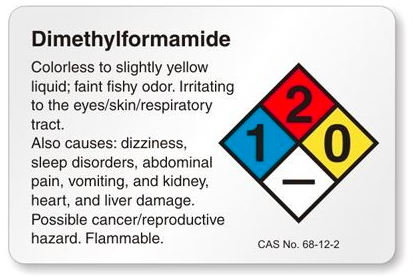DMF in Your Gloves? Here’s what you want to know
Safety gloves are supposed to protect you from hazards. They’re not supposed to be a hazard themselves.
And yet you have gloves made with DMF—a chemical that’s been widely acknowledged to have long-term hazardous effects to humans.
- What is DMF?
- What are its effects?
- Where can it be found?
- How can I avoid it?
We answer all these questions and more in this blog. Buckle up!
What is DMF?
DMF is shorthand for dimethylformamide, a chemical that is used in a variety of industries—including the production of many safety gloves.
DMF is a solvent used in acrylic fiber spinning, chemical manufacturing, and pharmaceuticals, and in products such as textile pigments, paint stripping solvents, coatings, and adhesives.

DMF was the subject of a health alert issued in the 1990’s by the National Institute of Occupational Safety and Health (NIOSH) that warned about the risks of exposure to DMF. Due to its harmful effects on the human body, European manufacturers have complied with REACH regulations and stopped using the chemical in their manufacturing process. However, it’s still in use in other countries, including the U.S.
What are the effects of DMF?
NIOSH warns that prolonged exposure to DMF can cause things like long-term liver damage, cancer, and acute exposures that induce heart palpitations, headaches, nausea, and vomiting. The chemical is readily absorbed through the skin and can cause contact sensitivity, similar to latex powder.
NIOSH places the permissible exposure limit (PEL) for DMF at 10 ppm over eight hours, and 20 ppm at the 15-minute short-term exposure limit, based primarily on injury to the liver.
In an independent test of coated polyurethane (PU) PPE gloves showed that DMF continued to be present after the final cleaning/rinse stage in production. Random testing of PU gloves in the market showed DMF levels from 49 all the way to 10,000 pm. These levers are 5 to 600 times greater than recommended exposure limits!
As a result, PPE that is supposed to keep employees safe can actually result in hazardous DMF exposure that can cause acute skin sensitivity, chronic dermatitis, and even long-term lethal health concerns–without anyone realizing it. The employee might go to a doctor to get their dermatitis examined, but if the doctor doesn’t know about DMF exposure, they could reach the wrong conclusion and prescribe ineffective treatment.
It’s very common for glove users to think they’re allergic to latex, when the real root cause of the irritation might be exposure to DMF.
Having said all that, DMF poses a much smaller risk for end users than for those involved in the glove manufacturing process, but it’s still there.
How do I know if my PPE has DMF?
One way to identify DMF in your coated gloves is the faint ammonia-like smell you may notice when removing the gloves from their packaging. Simply “airing them out” to dissipate the smell won’t remove the DMF from the glove material.
Double-gloving is a temporary solution at best, since it increases wearer discomfort and significantly increases PPE costs. Instead, wash your gloves thoroughly prior to use to reduce the levels of leftover DMF.
Another solution is to know where your gloves were manufactured or who manufactured them. Europe stopped using DMF in 2009, and so it’s reasonable to assume gloves made there would be DMF-free. We at Mechanix Wear elected to move away from DMF in our glove manufacturing process and now use safe alternatives.
Here are a few other ways to identify products with DMF:
- California Proposition 65 - If your products come with a proposition 65 warning, it is a good sign your gloves may contain DMF
- EU REACH - If your glove does not have REACH compliance, then that would be a sign that dangerous chemicals were used in its manufacturing

If you want to ensure your gloves are DMF-free, do the following:
- If you purchase PPE through a distributor, insist on DMF-free gloves
- If you purchase PPE directly, look for gloves that state they’re DMF-free
- To reduce research time, just learn who makes gloves without using DMF
What does Mechanix Wear use?
As mentioned above, Mechanix Wear does not use DMF in the manufacturing process. All of our water-based urethane SpeedKnit® gloves are free of both DMF and silicone. This unique water-based coating allows the wearer to maintain a good grip in both wet and dry conditions. That means the same benefits of traditional PU coated gloves without the risk of chemical exposure.
If you would like to know more about DMF-free hand protection, contact us for a free assessment.